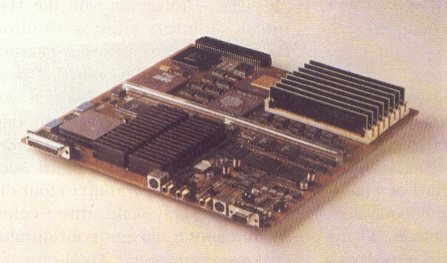|
Macworld Article Page 4 |
|||
|
|
The
Nextcube The original Next cube hasn't been dropped -- just renamed and upgraded. It's now called the Nextcube than the redesigned main logic board has the same features as the Nextstation: 68040/56001 combination, built-in video with 1120 by 832 resolution and four-color support, plus all the same ports. Individuals who already own a cube can even upgrade to the new main logic board for $1495. The basic Nextcube--with 8MB of RAM, 2.88MB floppy drive, 105MB hard drive, three open slots, and the MegaPixel Display--is only $7995; as with the Nextstations, you can select the 340MB hard drive instead for an extra $2000. What has changed is the selection of mass storage options. Since the floppy drive and standard hard drive fit together in the upper mass storage bay, the lower one is free to house a variety of devices. The Next optical disks drive is still an option (for an additional $2995) -- despite all the controversy that has surrounded it, the optical drive is a very popular feature among people who actually use the Next. Other options include a CD-ROM drive, a 660MB hard drive, and a 1.4GB hard drive. "Mac IIfx versus Nextcube" compares a beefed-up Nextcube system (16MB RAM, 340MB hard drive) with a comparably equipped Macintosh IIfx. This requires outfitting the IIfx with an Apple Two-Page Monochrome Monitor, extra memory (purchased at street prices, with credit for preinstalled memory), adding an EtherTalk board, and buying A/UX 2.0 on floppy disks. The Nextcube costs over $6000 less than the Mac IIfx, yet has better overall performance, twice the free disk space, built-in sound input, the DSP chip, and the extended Release 2.0 software suite, including full NextStep development tools. |
|
|

|
|
Nextdimension
Color Board While the new Next systems presents a significant performance improvement over the original Next cube, and for less money, they are still more evolutionary than revolutionary. The real bombshell dropped at the September 18 rollout was the Nextdimension color board. Next did a very good job of keeping many details about this board under wraps until the announcement, and with good reason: a punch is best landed when it's unexpected. In short, the Nextdimension color board combines the features of several Macintosh video boards put together. Next's price for this board is $3995, or less than a third of what it would cost to get roughly equivalent functionality on a Macintosh. What's more, the Nextdimension provides all this in a coordinated, integrated fashion, ensuring that these functions can be used together and are supported by standard Next system software. For example, live video coming in can be displayed in a regular window, which can be moved, resized, or hidden just like any other window. You can capture single-frame images, and then save them as color TIFF or EPS files. As with Mac video boards, the display produced by the Nextdimension is an extension of the regular desktop provided on the MegaPixel Display. As with the Macintosh Monitors cdev, a Monitors panel and the Preferences application enables you to adjust virtual positioning of the screens, and lets you select which display is the main one. And, as with the Mac, you can plug a Nextdimension board in to each empty slot, giving you up to four displays (one gray-scale, three color) forming one large, configurable desktop. |
|